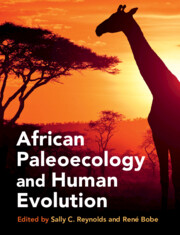Book contents
- African Paleoecology and Human Evolution
- African Paleoecology and Human Evolution
- Copyright page
- Dedication
- Contents
- Contributors
- Acknowledgments
- Part I Modern Africa and Overview of Late Cenozoic Paleoenvironments
- Part II Southern Africa
- 6 The Southern African Sites
- 7 Geology, Fauna, and Paleoenvironmental Reconstructions of the Makapansgat Limeworks Australopithecus africanus-Bearing Paleo-Cave
- 8 Paleoenvironments and the Context of Plio-Pleistocene Hominins at Kromdraai, South Africa
- 9 Using the Faunal Community to Determine the Local Ecology for Early Hominins at Cooper’s Cave at 1.5 Ma
- 10 The Paleoenvironments of Sterkfontein
- 11 Swartkrans: A Record of Paleoenvironmental Change in the Cradle of Humankind
- 12 Cornelia-Uitzoek: Paleoecology, Archeology, and Geochronology
- 13 The Paleoecology of the Australopithecus africanus Type Site at Taung, South Africa
- 14 Wonderwerk Cave, Northern Cape Province: An Early–Middle Pleistocene Paleoenvironmental Sequence for the Interior of South Africa
- Part III Eastern and Central Africa
- Part IV Northern Africa
- Volume References
- Index
- Plate Section (PDF Only)
13 - The Paleoecology of the Australopithecus africanus Type Site at Taung, South Africa
from Part II - Southern Africa
Published online by Cambridge University Press: 19 May 2022
- African Paleoecology and Human Evolution
- African Paleoecology and Human Evolution
- Copyright page
- Dedication
- Contents
- Contributors
- Acknowledgments
- Part I Modern Africa and Overview of Late Cenozoic Paleoenvironments
- Part II Southern Africa
- 6 The Southern African Sites
- 7 Geology, Fauna, and Paleoenvironmental Reconstructions of the Makapansgat Limeworks Australopithecus africanus-Bearing Paleo-Cave
- 8 Paleoenvironments and the Context of Plio-Pleistocene Hominins at Kromdraai, South Africa
- 9 Using the Faunal Community to Determine the Local Ecology for Early Hominins at Cooper’s Cave at 1.5 Ma
- 10 The Paleoenvironments of Sterkfontein
- 11 Swartkrans: A Record of Paleoenvironmental Change in the Cradle of Humankind
- 12 Cornelia-Uitzoek: Paleoecology, Archeology, and Geochronology
- 13 The Paleoecology of the Australopithecus africanus Type Site at Taung, South Africa
- 14 Wonderwerk Cave, Northern Cape Province: An Early–Middle Pleistocene Paleoenvironmental Sequence for the Interior of South Africa
- Part III Eastern and Central Africa
- Part IV Northern Africa
- Volume References
- Index
- Plate Section (PDF Only)
Summary
In November of 1924, Robert Young delivered a “cercopithecid” skull from the Buxton-Norlim Limeworks, near Taung, in what is now the North West Province of South Africa, for description to Australian anatomist Raymond Dart, of the University of the Witwatersrand Medical School (Dart, 1925a; Tobias, 1985). This primate specimen turned out to be the first early hominin fossil ever recovered from Africa and the juvenile type specimen for Australopithecus africanus (Dart, 1925a). Since this discovery a number of adult specimens have been found at cave sites in the Cradle of Humankind (e.g., Broom and Schepers, 1946; Dart, 1948; Broom et al., 1950), but no other hominin fossils have been recovered from the Type Site at Taung. As a direct result of Dart’s 1925a Nature paper, a number of researchers made exploratory trips to the Limeworks that resulted in a slew of early publications by Aleš Hrdlička (1925), Robert Young (1925), Lidio Cipriani (1928), Raymond Dart (1926, 1929), and Robert Broom (1925a, 1925b, 1929, 1930, 1934, 1938a, 1939, 1943, 1945, 1946, 1948a, 1948b). While these early investigations into the type locality of Au. africanus garnered a wide body of publications, a proper exploratory foray into the region only occurred in 1947–48 with the University of California Africa Expedition (Camp, 1948; Peabody, 1954). Twenty years later, Karl Butzer published his geological work (Butzer, 1974), and 11 years after that Timothy Partridge published his geological interpretations (Partridge, 1985). Prior to the renewed research in 2010, the last concerted effort into the region was from 1988 to 1994 under the direction of Phillip Tobias, of the University of the Witwatersrand School of Anatomical Sciences. The Tobias years were jointly run by Michel Toussaint and Jeffrey McKee in 1988; and solely by McKee thereafter (McKee and Tobias, 1990, 1994; McKee, 1993a, 1993b, 1994). During this time McKee mapped many of the previously discovered deposits along with a number of new fossil deposits (McKee, 1994). Of the 17 fossil deposits documented by McKee (1994),it is only the fossils collected from the Hrdlička and Dart Pinnacles (now known collectively as the Type Site; Kuhn et al., 2016) that are currently known to be of late Pliocene and Early Pleistocene age and as such are of relevance to early southern African hominin evolution. A new phase of geological and paleoecological research at the Type Site commenced in 2010 (Herries et al., 2013; Hopley et al., 2013; Doran et al., 2015; Kuhn et al., 2015, 2016; Parker et al., 2016).
- Type
- Chapter
- Information
- African Paleoecology and Human Evolution , pp. 135 - 141Publisher: Cambridge University PressPrint publication year: 2022



